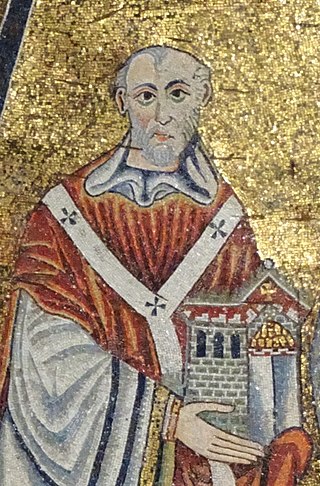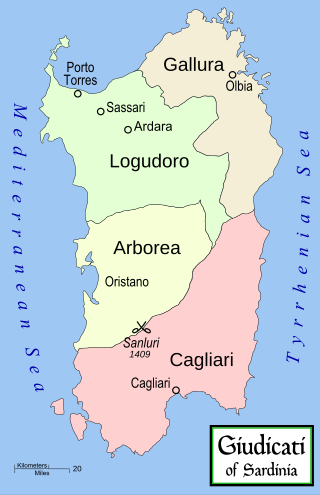Sources
- Pennington, Kenneth. Popes and Bishops: The Papal Monarchy in the Twelfth and Thirteenth Centuries. Philadelphia, 1984.
- Moore, John C. "Pope Innocent III, Sardinia, and the Papal State." Speculum, Vol. 62, No. 1. (Jan., 1987), pp 81–101.
Riccus or Ricco was the Archbishop of Cagliari in the early thirteenth century.
In 1206, he requested the right to resign from Pope Innocent III, who simply enumerated the justifications for archiepiscopal resignation and left the decision up to Riccus. [1] [2] The following year (1207), he approved of the marriage (incestuous by canon law) of Hugh I of Arborea and a daughter of William I of Cagliari. [2] He also did not intervene on the pope's behalf when Elena of Gallura, a ward of the pope, wed Lamberto di Eldizio without papal consent. For this, he received a stiff reprimand from Innocent. [2]

The Fourth Council of the Lateran or Lateran IV was convoked by Pope Innocent III in April 1213 and opened at the Lateran Palace in Rome on 11 November 1215. Due to the great length of time between the council's convocation and its meeting, many bishops had the opportunity to attend this council, which is considered by the Catholic Church to be the twelfth ecumenical council. The council addressed a number of issues, including the sacraments, the role of the laity, the treatment of Jews and heretics, and the organization of the church. In the case of Jews and Muslims, this included compelling them to wear distinctive badges to prevent social contact "through error".

Pope Celestine III, was the head of the Catholic Church and ruler of the Papal States from 30 March or 10 April 1191 to his death in 1198. He had a tense relationship with several monarchs, including Emperor Henry VI, King Tancred of Sicily, and King Alfonso IX of León.

Pope Gregory IX was head of the Catholic Church and the ruler of the Papal States from 19 March 1227 until his death in 1241. He is known for issuing the Decretales and instituting the Papal Inquisition, in response to the failures of the episcopal inquisitions established during the time of Pope Lucius III, by means of the papal bull Ad abolendam, issued in 1184.

Pope Innocent II, born Gregorio Papareschi, was head of the Catholic Church and ruler of the Papal States from 14 February 1130 to his death in 1143. His election as pope was controversial and the first eight years of his reign were marked by a struggle for recognition against the supporters of Anacletus II. He reached an understanding with King Lothair III of Germany who supported him against Anacletus and whom he crowned as Holy Roman emperor. Innocent went on to preside over the Second Lateran council.

Pope Innocent III, born Lotario dei Conti di Segni, was the head of the Catholic Church and ruler of the Papal States from 8 January 1198 until his death on 16 July 1216.
Henry of Segusio, usually called Hostiensis, was an Italian canonist of the thirteenth century, born at Susa (Segusio), in the ancient Diocese of Turin. He died at Lyon.

The Decretals of Gregory IX, also collectively called the Liber extra, are a source of medieval Catholic canon law. In 1230, Pope Gregory IX ordered his chaplain and confessor, Raymond of Penyafort, a Dominican, to form a new canonical collection destined to replace the Decretum Gratiani, which was the chief collection of legal writings for the church for over 90 years. It has been said that the pope used these letters to emphasize his power over the Universal Church.

William I, royal name Salusio IV, was the judike of Cagliari, meaning "King", from 1188 to his death. His descendants and those of his immediate competitors intermarried to form the backbone of the Italian Aristocracy, and ultimately their descendants in the Medici clan are precursors to, and definers of later royalty and claims thereto.
Barisone II Torchitorio IV de Serra was the Judike (Judge) of Arborea and Cagliari.
Elena was the daughter and successor of Barisone II of Gallura and was named after her mother Odolina of the Lacon family. First queen regnant in Sardinia, she ruled Gallura from the death of her father until her own death, though she was eclipsed by her husband after 1207.
Biagio was the Archbishop of Torres from 1 December 1202 to his death late 1214 or early 1215.
Benedetta was the daughter and heiress of William I of Cagliari and Adelasia, daughter of Moroello Malaspina. She succeeded her father in January or February 1214.

Peter I, of the Serra family, was the eldest son and successor of Barisone II of Arborea, reigning from 1186 to his death. His mother was Barisone's first wife, Pellegrina de Lacon. He was crowned King of Sardinia, the title his father had used, with the support of a majority of the Arborean nobility.
Peter of Benevento was an Italian canon lawyer, papal legate and cardinal.

Plenitudo potestatis was a term employed by medieval canonists to describe the jurisdictional power of the papacy. In the thirteenth century, the canonists used the term plenitudo potestatis to characterize the power of the pope within the church, or, more rarely, the pope's prerogative in the secular sphere. However, during the thirteenth century the pope's plenitudo potestatis expanded as the Church became increasingly centralized, and the pope's presence made itself felt every day in legislation, judicial appeals, and finance.

With a long history as a vantage point for anti-popes forces threatening Rome, Viterbo became a papal city in 1243. During the later thirteenth century, the ancient Italian city of Viterbo was the site of five papal elections and the residence of seven popes and their Curias, and it remains the location of four papal tombs. These popes resided in the Palazzo dei Papi di Viterbo alongside the Viterbo Cathedral intermittently for two decades, from 1257 to 1281; as a result, the papal palace in Viterbo, with that in Orvieto, are the most extensive thirteenth-century papal palaces to have survived.

Orvieto, Umbria, Italy, was the refuge of five popes during the 13th century: Urban IV (1261–1264), Gregory X (1271–1276), Martin IV (1281–1285), Nicholas IV (1288–1292) and Boniface VIII (1294–1303). During this time, the popes took up residence in the Papal Palace of Orvieto, which was adjacent to the Orvieto Cathedral and expanded onto the bishop's residence. None of these popes died in Orvieto, and thus no papal elections took place in there, nor are there any papal tombs.

Henryk Kietlicz was Archbishop of Gniezno from 1199 to 1219 was the main architect of the changes that allowed the Polish church to gain independence from the secular authorities.
The Tuscan League, also known as the League of San Genesio, was formed on 11 November 1197 at Borgo San Genesio by the chief cities, barons and bishops of the Duchy of Tuscany shortly after the death of the Emperor Henry VI. The league was the work of Pope Celestine III and his two papal legates: Pandulf, cardinal priest of Santi Apostoli, and Bernard, cardinal priest of San Pietro in Vincoli. It was directed against the Holy Roman Emperor in alliance with the papacy. Its members swore not to make any alliances without papal approval, nor to make any peace or truce "with any emperor, king, prince, duke or margrave" without the approval of the rectors of the league. The original signatories were the communes of Lucca, Florence and Siena, the people living under the castles of Prato and San Miniato, and the bishopric of Volterra. The city of Arezzo joined on 2 December; Pisa refused and was placed under interdict by Celestine.

The Quinque compilationes antiquae is a set of five collections of twelfth and thirteenth century decretals totalling between 1,971 and 2,139 chapters.